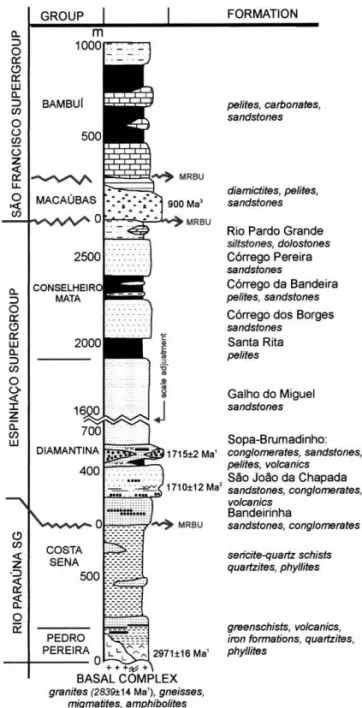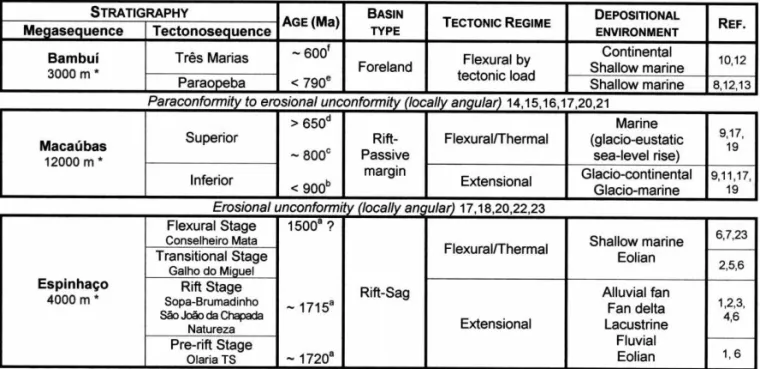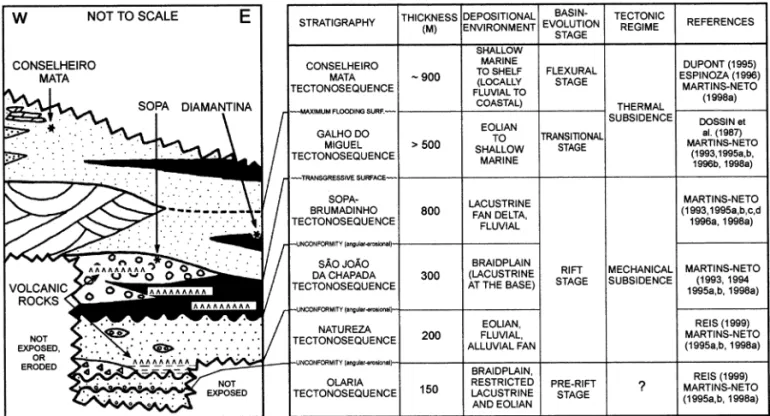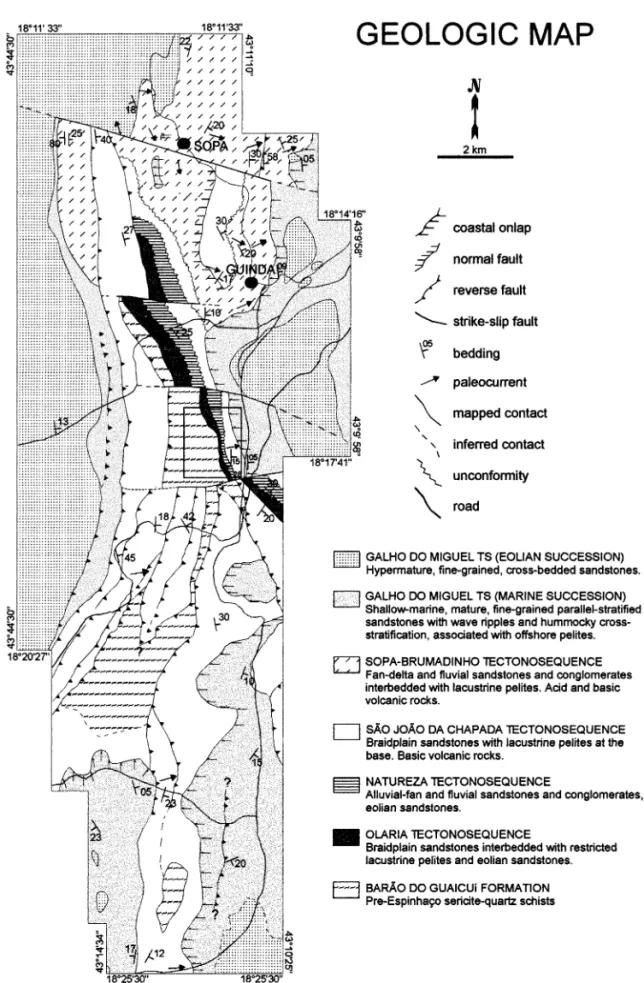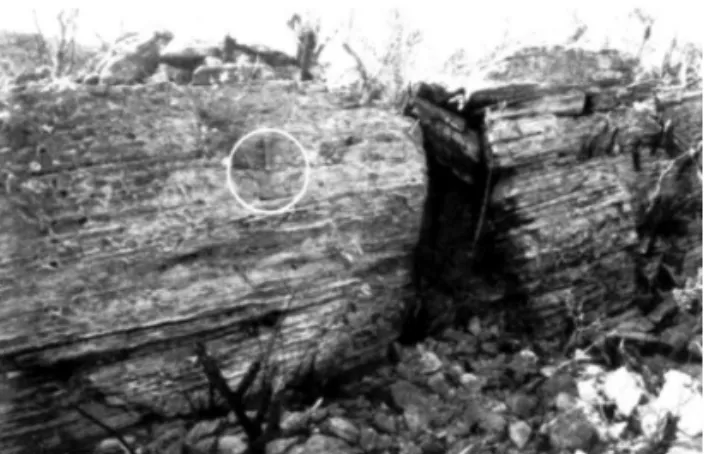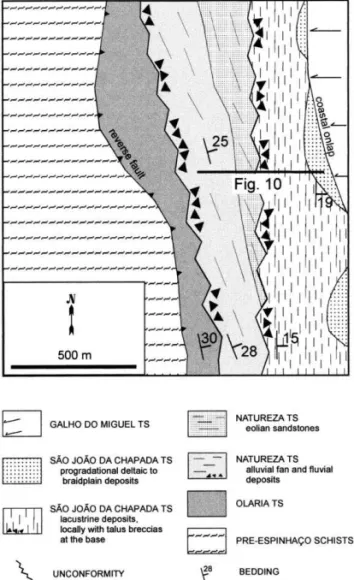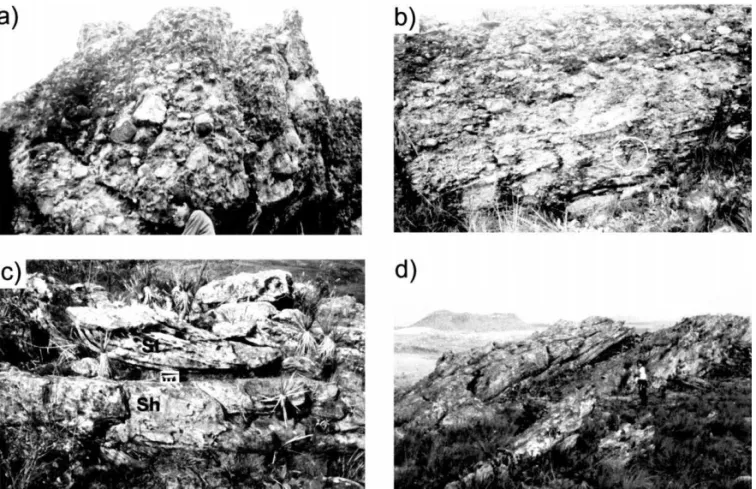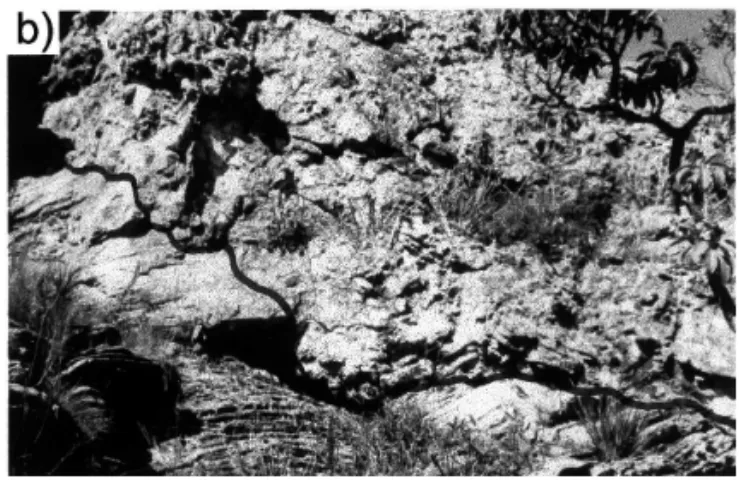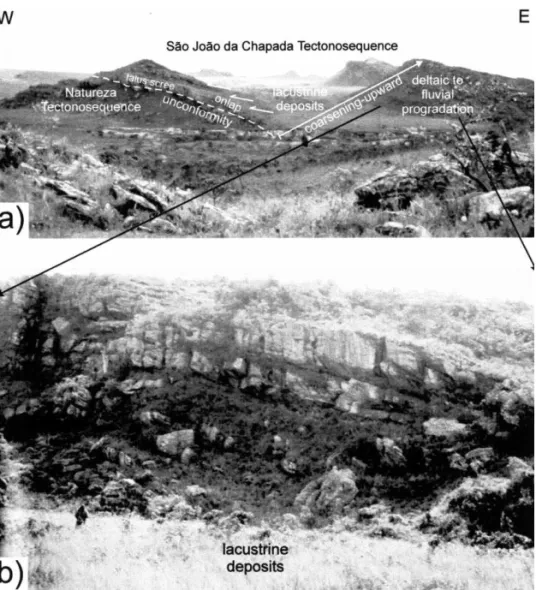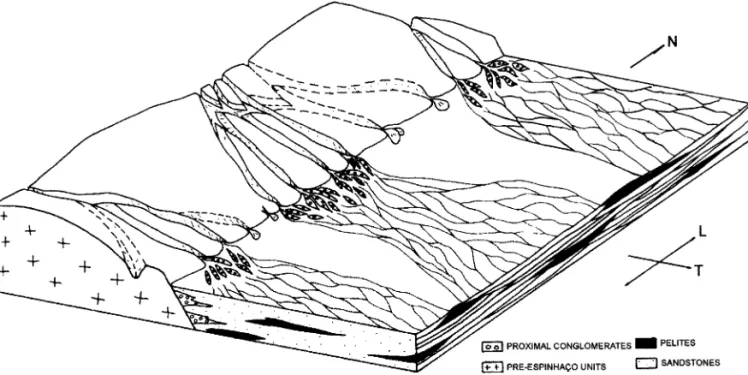Tectonics and sedimentation in a paleo
/
mesoproterozoic
rift-sag basin (Espinhac¸o basin, southeastern Brazil)
Marcelo A. Martins-Neto
Departamento de Geologia,Escola de Minas,Uni6ersidade Federal de Ouro Preto,Caixa Postal173, Campus Morro do Cruzeiro s/n,35400-000Ouro Preto,MG,Brazil
Received 2 June 1999; accepted 20 March 2000
Abstract
Sedimentologic, paleogeographic, stratigraphic, structural and tectonic studies in a paleo
/
mesoproterozoic
metased-imentary succession (Espinhac¸o Megasequence, southeastern Brazil) indicates deposition in a rift-sag basin. Four
basin evolution stages are recognized (prerift, rift, transitional and flexural). The four stages can be represented by six
unconformity-bounded tectonosequences. The unconformities are recognized in the field and mappable even on a
regional scale. The prerift and rift stages of the Espinhac¸o basin were filled by products of continental depositional
systems. The prerift stage probably represents the first product of the rifting process, before the development of the
half-grabens that characterize the rift stage. During the rift stage, mechanical subsidence due to lithospheric stretching
was predominant and led to episodic rising of the depositional base level. As a result, the basin fill is characterized
by coarsening-upward intervals. Paleocurrent patterns indicate that block tilting and half-graben subsidence
/
uplift
controlled sediment dispersion. The first marine incursion within the Espinhac¸o basin marks the change in the
subsidence regime of the basin. The evolution of the transitional and flexural stages was probably controlled by
thermal subsidence due to thermal contraction of the lithosphere during cooling. The transitional stage was
characterized by relatively low subsidence rates. Higher subsidence rates and a consequent sea-level rise characterize
the flexural stage of the Espinhac¸o basin, in which three second-order transgressive-progradational sequences can be
recognized. © 2000 Elsevier Science B.V. All rights reserved.
Keywords:Brazil; Proterozoic; Tectonostratigraphic units; Basin analysis; Tectonics; Sedimentation
www.elsevier.com/locate/precamres
1. Introduction
Rift-sag basins represent the tectonic product of
aborted passive-margin development (Allen and
Allen, 1990). These basins, commonly referred to
as aulacogens or failed rifts, display a ‘steer’s
head’ geometry due to early rifting and
sub-sequent thermally-driven downwarping (White
and McKenzie, 1988). The stratigraphic
frame-work, structural style, and tectonic evolution of
rift-sag basins have been interpreted mainly
through seismic reflection profiles (e.g. Meyerhoff,
1982; Schlee and Hinz, 1987; Badley et al., 1988).
With exceptions (e.g. Eriksson et al., 1993), few
E-mail address:[email protected] (M.A. Martins-Neto).examples based on direct field observations have
been published.
Deposits of the paleo
/
mesoproterozoic
Espin-hac¸o basin outcrop in the central and western parts
of the Serra do Espinhac¸o, southeastern Brazil
(Fig. 1). Because of inversion during the
neo-proterozoic (Brasiliano
/
Pan African orogeny), and
because of a deep erosional level, the Espinhac¸o
basin provides an opportunity to evaluate the
paleogeographic and tectonic evolution of a rift-sag
basin
through
outcrop
data.
Of
particular
importance, deposits recording initial rifting are
exposed. These constitute a valuable source of data
to characterize the three-dimensional architecture
of an early half-graben, and to document the
relationships between tectonics and sedimentation
that might not be available through geophysical
studies alone.
This
paper
presents
a
model
for
the
tectono-sedimentary evolution of the Espinhac¸o
rift-sag basin, based on geological mapping and
integrated
sedimentologic,
paleogeographic,
stratigraphic, structural and tectonic studies,
carried out in the central and western parts of the
southern Serra do Espinhac¸o, Brazil (Fig. 1). Early
workers (e.g. Pflug, 1965) described the Espinhac¸o
supergroup
as
a
miogeosynclinal
sequence.
Subsequently, a rift to passive-margin setting was
proposed (Pflug et al., 1980), and Martins-Neto
(1993), Schobbenhaus (1993), Dussin and Dussin
(1995) suggested, based on the ensialic setting and
stratigraphic
framework,
deposition
in
an
intracratonic basin, with an initial rift phase and a
subsequent flexural phase. The present paper
provides detail documenting the prerift, rift,
transitional and flexural stages of basin evolution.
2. Regional setting
The southern Serra do Espinhac¸o belongs to the
external zone of the Arac¸uaı´ fold-thrust belt,
Fig. 2. Lithostratigraphy of the southern Serra do Espinhac¸o after Pflug (1968), Fogac¸a et al. (1984), Dossin et al. (1984), Almeida Abreu and Pflug (1992) (modified after Martins-Neto, 1993). Geochronological ages are from (1) Machado et al. (1989), (2) Dussin and Dussin (1995) and (3) Buch-waldt et al. (1999). MRBU, major regional bounding uncon-formity.
Fig. 3. Stratigraphic framework and tectono-depositional features of the paleo/meso and neoproterozoic cover sequences of the Sa˜o Francisco craton and external zone of the Arac¸uaı´ fold belt.
along the southeastern margin of the
neo-proterozoic Sa˜o Francisco craton, southeastern
Brazil (Fig. 1; Brito Neves and Cordani, 1991;
Trompette et al., 1992; Schobbenhaus, 1993;
Alkmim et al., 1993; Martins-Neto, 1998a). The
paleo
/
mesoproterozoic Espinhac¸o supergroup (Fig.
2) is the predominant unit in the southern Serra do
Espinhac¸o,
overlying
the
archean
basement
complex and supracrustal rocks of the archean
/
paleoproterozoic Rio Parau´na supergroup
uncon-formably (Pflug, 1965). It is in turn unconuncon-formably
overlain by the neoproterozoic Sa˜o Francisco
supergroup (Fig. 2; Pflug and Renger, 1973;
Dupont, 1996; Martins-Neto et al., 1997a,b, 1999a).
The maximum age of the Espinhac¸o supergroup
is limited by U
/
Pb dating of metamorphic zircon
in pre-Espinhac¸o units (1844
9
15 Ma; Machado et
al., 1989), and depositional ages from magmatic
zircons in volcanic-bearing units in the lower parts
of the Espinhac¸o supergroup include, (1) 1711 Ma
(U
/
Pb;
N.
Machado
oral
commun.,
1993;
in
Schobbenhaus,
1993);
(2)
1710
9
12
Ma
(
207Pb
/
206Pb; Dussin and Dussin, 1995); and
(3) 1715
9
2 Ma (U
/
Pb; Machado et al., 1989). The
minimum age of the Espinhac¸o supergroup is
less constrained, and is currently defined by basic
intrusions that cut the entire column (ca. 1.1 –
0.9 Ga; Brito Neves et al., 1979; Machado et al.,
1989).
The southern Serra do Espinhac¸o was deformed
and metamorphosed in the Brasiliano
/
Pan African
Fig. 4. Stratigraphic chart for the Espinhac¸o Megasequence showing the main characteristics of the tectono-sedimentary units (modified from Martins-Neto, 1995a).
3. Stratigraphic framework
The Espinhac¸o supergroup is a thick (
4000
m) succession of siliciclastic metasedimentary
rocks containing subordinate volcanic intervals
(Fig. 2). These have been grouped
lithostratigraph-ically into nine formations (Pflug, 1968; Almeida
Abreu and Pflug, 1992). Herein, adopting a genetic
stratigraphic approach, the Espinhac¸o supergroup
is referred to as the ‘Espinhac¸o Megasequence’,
which is the record of an unconformity-bounded,
single basin-fill cycle. The basin-fill cycle is
com-posed of six tectonosequences, from bottom to top
(Figs. 3 and 4), the Olaria tectonosequence (prerift
stage), the Natureza, Sa˜o Joa˜o da Chapada and
Sopa-Brumadinho tectonosequences (rift stage);
the Galho do Miguel tectonosequence (transitional
stage) and the Conselheiro Mata tectonosequence
(flexural stage). Each tectonosequence records
linked depositional systems accumulated in a
spe-cific tectonic phase of the basin, and is defined by
major regional bounding unconformities (Fig. 4;
Da Silva, 1993; Martins-Neto, 1995a,b). These
unconformities represent periods of significant
tec-tonically induced paleogeographic reorganization.
During the rift stage, mechanical subsidence due to
lithospheric stretching controlled basin evolution.
The transitional and flexural stages were
trolled by thermal subsidence arising from
con-traction of the lithosphere due to cooling.
The genetic stratigraphic approach adopted
herein is based on the definition of a major
uncon-formity-bounded megasequence, allowing
recogni-tion and analysis of a true basin entity, even
though its life span is not well constrained. Each
tectonosequence represents the record of an
evolu-tionary stage of the basin, with its own
accommo-dation history. Contacts are recognized in the field
and mappable even on a regional scale (Fig. 5).
4. Prerift stage: Olaria tectonosequence
Fig. 6. Photograph showing sheet-flood sandstones of the Olaria braidplain deposits. Note hammer (circled) for scale.
terpretations are limited by poor outcrop and
high strain, the lack of volcanic rocks and of
evidence of synsedimentary faults (in contrast to
overlying sequences) suggest that the Olaria
tec-tonosequence was deposited in an initial sag that
was the product of ductile stretching, before the
upper crust had reached its elastic limit.
How-ever, clastic dykes filled by conglomeratic
sand-stones
occur
at
the
top
of
the
Olaria
tectonosequence. These are truncated at the
an-gular unconformity with the overlying Natureza
tectonosequence, and are likely precursors of
ac-tive shallow-level faulting.
5. Rift stage: Natureza; Sa˜o Joa˜o da Chapada;
Sopa-Brumadinho tectonosequences
The rift stage of the Espinhac¸o basin is
charac-terized by three phases all of which are bounded
by angular unconformities (Figs. 4, 5 and 7),
synrift 1 (Natureza tectonosequence); synrift 2
(Sa˜o Joa˜o da Chapada tectonosequence); and
synrift 3 (Sopa-Brumadinho tectonosequence).
5.1.
Synrift
1
phase
(
Natureza tectonosequence
)
The Natureza tectonosequence is up to 200 m
thick (cf. Reis, 1999). Massive and inversely
graded clast-supported conglomerates interpreted
as debris-flow deposits (Fig. 8a) occur above the
mudstones (sericitic phyllites). The deposits are
likely high-energy ephemeral flood deposits
simi-lar to those described by Tunbridge (1981, 1984).
Some lenticular bodies composed of fine-grained
sandstones with high textural maturity occur in
the middle portion of the unit (Reis, 1999). These
display large-scale cross-stratification (sets up to
3 m thick) with high-angle (30 – 35°) truncations
may be suggestive of an eolian origin. Thick
layers of sericitic phyllites, which may represent
deposition in ponds, occur locally.
The available data (Table 1) suggest that the
Olaria tectonosequence was probably deposited
in alluvial braidplains associated with restricted
lacustrine and eolian environments. Although
in-Table 1
Summary of the depositional characteristics of the Olaria tectonosequence
Depositional Key lithologies Sedimentary features Depositional process
setting
Sheet floods under upper flow Poorly-sorted, medium to
Alluvial Parallel-stratification, sheet like
braidplain fine-grained sandstones geometry regime
Poorly-sorted, medium to Trough cross-stratification 3D-dune migration (sensu Ashley,
fine-grained sandstones 1990) under lower flow regime
Planar cross-stratification
Poorly-sorted, medium to 2D-dune migration (sansu Ashley,
1990) under lower flow regime fine-grained sandstones
Fine-grained sandstones Ripple cross-lamination Current-ripple migration Floodplain deposits
Pelites Thin mud drapes
Vertical accretion
Pelites Metric thick bodies
Lacustrine
Eolian dune migration Metric thick cross-beds with
Eolian Hypermature fine-grained
basal angular unconformity. The debris-flow
conglomerates are associated with clast- and
matrix-supported stratified conglomerates
con-sidered as traction deposits (Fig. 8b) and are
interpreted as having been deposited in an alluvial
fan and braided stream depositional system. The
conglomeratic deposits are covered by a sandy
braided fluvial succession (Fig. 8c) interbedded
with eolian sandstones (Fig. 8d, Table 2) (Silva,
1995; Reis, 1999).
Conglomerate
sections
and
the
angular
character of the unconformity at the base of the
Natureza
tectonosequence
are
suggestive
of
tectonic influence such as block tilting or selective
uplift and
/
or subsidence. This signifies rupture of
the upper crust and the development of the first
half-grabens in the Espinhac¸o basin. The limited
areal extent of the Natureza tectonosequence
suggests a restricted character of the basin at this
time. The absence of volcanic rocks infers a
stretching factor
b
(White and McKenzie, 1988)
of less than 2 for this phase.
5.2.
Synrift
2
phase
: (
Sa˜o Joa˜o da Chapada
tectonosequence
)
The Sa˜o Joa˜o da Chapada tectonosequence is
up to 300 m thick. Locally, above the angular
unconformity (Fig. 9), conglomerates and breccias
contain abundant sandstone clasts derived from
the underlying Natureza tectonosequence. These
have been interpreted as fault-scarp talus deposits
formed by cohesionless mass-flows, and are strong
indicators of repeated local fault uplift and
canni-balization as part of the rifting process
(Martins-Neto, 1993).
The onset of volcanism in the evolution of the
Espinhac¸o basin is marked by basic rocks near the
base of the Sa˜o Joa˜o da Chapada
tectonose-quence (Hoppe and Otto, 1982; Uhlein, 1991;
Schobbenhaus, 1993; Dussin, 1994; Dussin and
Dussin, 1995). Layers of hematitic phyllites within
these units have been interpreted as volcanic beds
altered by Paleoproterozoic subaerial weathering
(lateritization) and subsequent metamorphism
(Knauer and Schrank, 1993).
The Sa˜o Joa˜o da Chapada tectonosequence
defines an overall coarsening-upward succession
from lacustrine to deltaic to fluvial deposits (Fig.
10). Fine-grained sandstones and pelites at the
base, probably deposited in a storm-influenced
lacustrine environment, represent rapid
subsi-dence and abrupt basin deepening. These are
overlain by sandstone bodies of likely deltaic
origin that display a sigmoidal geometry and are
arranged in coarsening- and thickening-upward
sequences. Prograding over the deltaic
/
lacustrine
deposits are extensive braidplain sandstones that
Fig. 7. Geologic map showing the angular character, denotedFig. 8. Photographs showing deposits of the synrift 1 Natureza tectonosequence, (a) Debris-flow conglomerates. Note inverse grading in the body comprising the lower half of the outcrop; (b) stratified, sheet-flood conglomerates. Note hammer (circled) for scale; (c) horizontally stratified (Sh) and trough stratified sandstones (St) of braided fluvial origin; (d) metric-scale cross-stratified sandstones of eolian origin.
constitute ca. 80% of the Sa˜o Joa˜o da Chapada
tectonosequence. These signify relatively reduced
rates of subsidence (Martins-Neto, 1993, 1994).
The Sa˜o Joa˜o da Chapada braidplain deposits
(Table 3, Fig. 11a) are characterized by sheet-like
bodies of coarse and poorly-sorted sandstones
that display unidirectional paleocurrents with
re-markably little dispersion throughout the study
area (Fig. 11b). The sandstones generally define
fining- and thinning-upward sequences and are
invariably bounded by low-relief erosional
sur-faces (Martins-Neto, 1994). Typical sequences
start with parallel-stratified and low-angle
cross-stratified sandstones (Sh
/
Sl) and are capped by
trough cross-stratified sandstones (St) and locally,
mudstone layers, characteristic of high-energy
ephemeral streams (e.g. Miall and Gibling, 1978;
Tunbridge, 1981, 1984; Lawrence and Williams,
1987; Mun˜oz et al., 1992). As detailed elsewhere
(Martins-Neto, 1994), the superposition of such
waning-flood sheet sandstones built up a
braid-plain that extended ca. 35 km transverse to the
regional paleoslope (Fig. 12).
5.3.
Synrift
3
phase
(
Sopa
-
Brumadinho
tectonosequence
)
Table 2
Facies of the Natureza tectonosequence and interpretation
Facies Interpretation
Massive to inversely Debris flows graded, clast-supported
conglomerates
Parallel-stratified, Traction deposits matrix-supported
conglomerates
Parallel-stratified, Sheet floods under upper flow regime
poorly-sorted sandstones
Trough cross-stratified, Fluvial 3D-dune migration (sensu Ashley, 1990) under poorly sorted sandstones
lower flow regime Planar cross-stratified, Fluvial 2D-dune migration
poorly sorted sandstones (sensu Ashley, 1990) under lower flow regime Ripple cross-laminated Current-ripple migration
sandstones
Floodplain deposits Pelites
Eolian dune migration Hypermature fine-grained,
metric thick coss-bedded sandstones
Fig. 9. Photographs showing (a) view of the angular unconfor-mity separating the Natureza and Sa˜o Joa˜o da Chapada tectonosequences and (b) detail emphasizing the erosional nature of this unconformity.
discussed in the following sub-headings,
lacus-trine, fan-delta and fluvial sedimentation took
place in half-grabens that were
compartmental-ized by north-trending normal faults and
east-trending transfer faults. Subsidence was episodic
and controlled by block tilting in asymmetric
grabens.
5.3.1.
Lacustrine
,
fan
-
delta and flu
6
ial deposits
The facies of the Sopa-Brumadinho
tectonose-quence are arranged in 40 – 80 m thick setectonose-quences
that coarsen and then fine upward (Fig. 13a and
b). At the base of each sequence are laminated
pelites (facies F). These are followed by, graded
and stratified sandstone beds (facies Sg); massive,
parallel-stratified, trough cross-stratified, and
pla-nar cross-stratified sandstones (facies Sm, Sh, St,
and Sp); and predominantly debris flow
conglom-eratic units (Table 4). The conglomerates then fine
upward to various sandstone facies (Fig. 13a).
Some sequences lack the lower turbiditic graded
sandstone component, and laminated mudstones
pass directly to stacked streamflood sandstones
(e.g. Fig. 13b). Mudlumps, formed by the rapid
loading of debris-flows onto water-saturated
muds (Dailly, 1976; Lewis, 1997) are locally
devel-oped. An approximately 200 m thick section of
parallel-stratified, trough cross-stratified and
pla-nar cross-stratified sandstones (
9
pelites)
inter-venes within the predominantly cyclic succession
(Reis, 1999; Martins-Neto et al., 1999b).
Table 4 summarizes the 13 facies of the
Sopa-Brumadinho tectonosequence and their
interpre-tation. More detailed descriptions of these facies
and the sedimentary processes that generated
them can be found in Martins-Neto (1995d,
1996b).
Fig. 10. (a) Outcrop section (see Fig. 7 for location) showing the overall coarsening-upward arrangement from lacustrine to deltaic to fluvial deposits of the Sa˜o Joa˜o da Chapada tectonosequence; (b) detail showing the thickening-upward arrangement of the initial deltaic progradation.
Table 3
Facies of the Sa˜o Joa˜o da Chapada braidplain deposits (codes modified after Miall, 1978)
Code Characteristics Interpretation
Massive to parallel-stratified conglomerates
Gm Migration of longitudinal bars
Sh/Sl Parallel-stratified to low-angle (B10°) cross-stratified Sheet floods under upper flow regime sandstones
Trough cross-stratified sandstones
St 3D-dune migration (sensu Ashley, 1990) under lower
flow regime Planar cross-stratified sandstones
Sp 2D-dune migration (sensu Ashley, 1990) under lower
flow regime
Current-ripple migration Sr Ripple cross-laminated sandstones
Floodplain deposits
Fig. 11. (a) Measured sedimentological sections of the Sa˜o Joa˜o da Chapada braidplain deposits. Geological map modified from Scho¨ll and Fogac¸a (1981), Chaves et al. (1985). (b) Paleocurrent data from Sa˜o Joa˜o da Chapada braidplain (316 measurements from cross-stratified sandstones). Modified after Martins-Neto (1993).
sequences are interpreted to represent repeated
episodes of rapid flooding (basal laminated mud
units) followed by progradation of fan lobes
which evolved from distal (subaqueous) to
proxi-mal (subaerial) environments. The fining-upward
parts represent the abandonment phases of the
depositional lobes. Discriminating between
lacus-trine and shallow marine deposits is commonly
difficult in Precambrian strata (e.g. Eriksson et
al., 1998). A lacustrine origin is favored in the
present example because pelitic rocks of facies F
define a number of isolated N – S elongate lenses.
5.3.2.
Tectonically
-
dri
6
en cyclicity
The lacustrine, fan-delta and fluvial
coarsening-upward and fining-coarsening-upward sequences are
consid-ered to represent repeated tectonically-driven
pulses (see e.g. Blair and Bilodeau, 1988).
Accord-ingly, flood surfaces and pelitic rocks at the base
of each sequence are the immediate response to
fault-induced subsidence of the basin floor, and
subsequent fan-delta progradation records a
de-layed response, reflecting erosional stripping of
relatively uplifted source areas. Fining-upward
trends at the top of the sequences signify a
reduc-tion in source-area relief during continued
tec-tonic quiescence.
Fig. 13b) may imply shallower lakes.
Smaller-scale pulses may be recorded by thin pelite layers
interbedded with some of the sandstones near the
base of the sequences (Fig. 13a and b and Fig.
14a). Although post-depositional processes have
strongly modified the original thicknesses of these
layers, thickness variation suggests varying
subsi-dence pulse magnitudes.
5.3.3.
Half
-
graben geometry
In regional cross section, fan development is
asymmetric. In the west, diamond mining
opera-tions have exposed the spatial and angular
rela-tionships between two fan-deltas (Fig. 14a). The
younger lobe (Lavrinha mine) forms a wedge
positioned basinward of an older fan segment
(Diamante Vermelho mine). Correction for
tec-tonic tilt using marine deposits of the overlying
Galho do Miguel tectonosequence as a
paleohori-zontal datum, yields a primary dip of ca.10 – 15°
for the older fan segment and ca. 5 – 10° for the
younger fan. These results are compatible with
published data of recent fan slopes (cf. Wells,
1984; Blair and McPherson, 1994). Basinward
stepping and increasing angle of tilt with age
(reflecting progressive rotation due to faulting) is
characteristic of many fans, modern and ancient
(e.g. Hooke, 1972; Steel et al., 1977; Heward,
1978a,b; Kleinspehn et al., 1984; Blair, 1987). In
contrast to these basinward stepping lobes, to the
northeast, at the Brumadinho mine (Fig. 14b),
clast-supported talus breccias form vertically
stacked linear bodies in direct fault contact with
older rocks. The two types of fans (Fig. 15) as
well as the geologic map and the cross-section
A – A
%
in Fig. 16 indicate an asymmetric-graben
geometry, with the Diamante Vermelho
/
Lavrinha
system representing hanging-wall sourced fans at
the unfaulted ramping margin, and the
Brumad-inho fans marking footwall sourced fans at the
faulted border (cf. Hooke, 1972; Gawthorpe and
Colella, 1990).
5.3.4.
Synsedimentary faults
East-trending transfer faults can be recognized
(Figs. 5 and 16). Paleocurrent patterns illustrate
the control exerted by transfer faults and
fault-bounded blocks on sediment dispersal (Fig. 16).
North of an east-trending transfer fault located
Table 4
Facies of the Sopa-Brumadinho tectonosequence (conglomer-ate codes after Martins-Neto, 1993, 1996b; sandstone codes after Miall, 1978)
Code Characteristics Interpretation Ungraded
UG-CS Cohesionless debria
clast-supported flows conglomerates
Inversely graded Cohesionless debris IG-CS
clast-supported flows conglomerates
Normally graded
NG-CS Cohesionless debris
flows clast-supporte
conglomerates
Crudely stratified Hyperconcentrated CS-CS
clast-supported flows conglomerates
TB-CS Talus-breccia Fault-adjacent talus clast-supported breccias
conglomerates Sand matrix-supported
S-MS Cohesionless debris
flows conglomerates
Mud matrix-supported Cohesive debris flows M-MS
conglomerates
Sm Massive sandstones Hyperconcentrated flows
Parallel-stratified
Sh Sheet floods under
upper flow regime sandstones
Trough cross-stratified
St 3D-dune migration
sandstones (sensu Ashley, 1990) under lower flow regime
Sp Planar cross-stratified 2D-dune migration sandstones (sensu Ashley, 1990)
under lower flow regime
Graded-stratified
Sg Turbidity currents
sandstones
F Pelites Vertically accreted
lacustrine deposits
Chapada, Natureza, and Olaria tectonosequences
(section A – A
%
, Fig. 16).
Several minor north-trending normal faults are
preserved in the Sopa-Brumadinho deposits. These
structures do not cut overlying beds,
demonstrat-ing that they formed as synsedimentary growth
faults (Fig. 17). East-trending ‘release faults’
(De-stro, 1995) are normal faults that terminate
against, and accommodate differential
displace-ment along, the north-trending structures (Fig. 18).
5.3.5.
Bimodal
6
olcanic rocks
Mafic and felsic volcanic rocks form local
in-terbeds in the Sopa-Brumadinho tectonosequence.
The rhyolites and their intrusive counterparts
(Borrachudos Suite) display a metaluminous to
subalkalic character and are enriched in K, Fe, Nb,
Y, Zr, Ga and light REE (Dussin, 1994; Dussin
and Dussin, 1995). According to Dussin and
Dussin (1995), the geochemical data and isotopic
compositions of Nd (
oNd1730 Ma
between
−
10.1 and
−
6.2) and of Sr (
87Sr
/
86Sr
i
=
0.7057) indicate
par-tial melting of crustal sources, typical of
continen-tal rift settings.
6. Transitional stage: Galho do Miguel
tectonosequence
The first marine incursion within the Espinhac¸o
Basin, represented by deposits of the Galho do
Miguel tectonosequence, marks the beginning of
the transitional stage (Martins-Neto, 1993). A
regionally mappable transgressive surface
sepa-rates these deposits from the underlying rift
succes-sion (Figs. 5, 14, 16 and 19). The Galho do Miguel
tectonosequence contains basal shallow-marine
de-posits that onlapped underlying units from the
east, and extensive eolian sand sheets that
pro-graded from the west (Table 5).
Wave and storm-dominated siliciclastic shelf
deposits define a lower transgressive succession
and an upper progradational succession (Table 5,
Fig. 20a). Paleocurrent data (Fig. 20b) and facies
distribution suggest a north-trending shoreline
and east-dipping paleoslope. In the transgressive
succession, shoreface, transition-zone and
off-shore deposits can be recognized. In the
prograda-south of Sopa, paleocurrents are easterly, roughly
tional succession, a complete offshore to coastal
suite of facies is developed (offshore, transition
zone, lower shoreface, upper shoreface, beach,
eolian). In contrast to underlying units, overall
rates of sediment supply were low relative to rates
of subsidence and
/
or sea-level rise. The initial
transgressive succession probably reflects an
inad-equate sediment supply compared with the rate of
relative sea-level rise, whereas the progradational
succession probably resulted from sediment
sup-ply exceeding relative sea-level rise.
The paleogeography of the Galho do Miguel
tectonosequence was strongly controlled by the
final disposition of earlier rift stages. This is
illus-trated by the distribution of eolian deposits (Figs.
5 and 21). Above synrift 3 (Sopa-Brumadinho
tectonosequence) depocenters, the dune fields
pro-graded eastward, whereas above structural highs
eolian deposits are thin or absent, and eolian
dunes did not reach the eastern parts of the
Espinhac¸o range.
The Galho do Miguel tectonosequence marks
the change from predominantly mechanical,
lo-cally compensated subsidence to thermal,
region-ally compensated subsidence. This transitional
stage was characterized by relatively low
subsi-dence rates by comparison to the previous and
subsequent stages. The resultant decrease in
ac-commodation space caused enlargement of the
basin, as the sediment supply was maintained. In
addition, increased flexural rigidity due to
litho-spheric cooling likely favored basin widening.
7. Flexural stage: Conselheiro Mata
tectonosequence
The deposits of the flexural stage of the
Espin-hac¸o basin belong to the ca. 900 m thick
Fig. 15. Sketch showing the spatial relationship between depositional lobes in half-grabens, (a) progradational relationship between hanging-wall-derived fans at the flexural border (see Fig. 14a and section AA% on Fig. 16) and (b) aggradational relationship (vertically stacked) between footwall-derived fans at the fault border (see Fig. 14b and section AA%on Fig. 16) (modified from Heward, 1978b).
heiro Mata tectonosequence. The base of this unit
is defined by a maximum flooding surface, which
marks the greatest expansion of the Espinhac¸o sea
(Martins-Neto, 1995b; Espinoza, 1996). Locally,
the lower boundary is defined by multiple
shoal-ing-upward sequences 10 – 20 m thick (Fig. 22;
Espinoza, 1996).
According to Dupont (1995), three depositional
sequences with a transgressive base and a
progra-dational top can be recognized in the Conselheiro
Mata tectonosequence (Fig. 23). The first
se-quence (250 – 400 m thick) contains transgressive
barred nearshore deposits and progradational
beach to shallow-marine deposits (Dupont, 1995;
Espinoza, 1996). The second sequence (250 – 350
m thick) comprises transgressive shelf deposits
overlain by progradational alluvial plain to
coastal successions (Dupont, 1995). The third
se-quence (200 – 300 m thick) is defined by
transgres-sive mixed siliciclastic – carbonate shelf deposits
overlain by coastal to fluvial sediments (Batista et
al., 1986; Dupont, 1995). The top of the third
depositional sequence marks the final filling up of
the Espinhac¸o basin. The thicknesses (ca. 300 m)
and the estimated time (some 10 million years) for
deposition of each sequence suggest that they may
represent
tectonically
controlled
second-order
product of variations in the in-plane stress field
(Martins-Neto, 1998a).
8. Discussion
Some aspects regarding the evolution of the
Espinhac¸o basin remain uncertain. One
impor-tant question concerns the larger-scale structure
of the rift stage. The dimensions of the
half-grabens described above indicate that they are
relatively minor structures, and evidence of
link-age to a master fault is lacking. However, the
predominance of eastward-directed paleocurrents
in deposits related to lateral-transport systems
(Leeder and Gawthorpe, 1987) may indicate a
master fault located to the east, outside the study
area (see Martins-Neto, 1994, 1996b). Thick
con-glomeratic successions in the eastern domains of
the Espinhac¸o range may be related to such a
Fig. 18. East-trending synsedimentary ‘release faults’ (Destro, 1995), which terminate against the north-trending normal fault of Fig. 17.
Fig. 17. Photograph and sketch showing minor north-trending synsedimentary normal fault preserved in the Sopa-Brumad-inho deposits. The fault controlled the site of conglomerate deposition. Photograph taken in the Diamante Vermelho dia-mond mine (see Fig. 14 for location of the mine).
master fault, but full documentation is inhibited
by intense Brasiliano
/
Pan African deformation.
Fig. 19. Outcrop section and interpretation sketch showing transgressive surface separating lacustrine pelites and a small deltaic lobe of the rift stage from shallow-marine transgressive deposits of the Galho do Miguel tectonosequence (transitional stage) (modified after Martins-Neto, 1993).
Table 5
Summary of the depositional characteristics of the Galho do Miguel tectonosequence
Depositional process Depositional Key lithologies Sedimentary features
setting
Eolian Hypermature fine-grained Metric to decametric thick Eolian dune migration by sandstones cross-beds; ripple marks; bimodal combination of sand-flow and
lamination sand-fall
Beach Medium-grained sandstones with Parallel-lamination or stratification Beach lamination (Clifton, 1979), locally with internal inverse grain segregation within heavy-minerals levels
grading; low-angel truncations; high-energy flows during wave backwash
ripple marks
Upper shoreface Amalgamated well-sorted, fine- to Parallel lamination; wave ripples; Intercalation of storm and medium-grained sandstone beds locally small-scale, trough and fair-weather wave-induced
processes planar cross-stratification
with heavy-minerals levels Amalgamated well-sorted,
Lower shoreface Parallel to slightly undulated Amalgamated storm events
lamination; hummocky fine-grained sandstones
cross-stratification; wave ripples
Transition zone Fine-grained sandstones Parallel stratification; hummocky Discrete storm beds (Dott and Bourgeois, 1982; Walker et al., cross-stratification; wave ripples
interbedded with pelites
1983) interbedded with fair-weather muds
Sheet-like layers with normal Vertical accretion of mud bellow Sericitic phylites (metamorphosed
Offshore
storm wave base with intervening grading from sandstones to
mudstones) with centimetric
Fig. 21. Cross-stratified sandstone of the Galho do Miguel eolian deposits.
tonosequences
(in
ascending
order),
Olaria,
Natureza, Sa˜o Joa˜o da Chapada,
Sopa-Brumad-inho, Galho do Miguel, Conselheiro Mata. The
Olaria tectonosequence records the prerift stage,
the Natureza, Sa˜o Joa˜o da Chapada and
Sopa-Brumadinho tectonosequences record the rift
stage, the Galho do Miguel tectonosequence the
transitional stage, and the Conselheiro Mata
tec-tonosequence the flexural stage. Each
tectonose-Fig. 22. Sedimentological section measured along the Pedreira creek at the eastern border of the Serra do Cabral (see Fig. 1 for location), showing the coarsening-upward rhythms which characterize the marine transgression at the transition between the Galho do Miguel and Conselheiro Mata tectonosequences (modified after Espinoza, 1996).
thickness measured in the central part of the
Espinhac¸o range.
The full life span of the Espinhac¸o basin
re-mains unknown and further geochronologic data
are required. Available geochronologic data
indi-cate rifting at ca. 1720 Ma. Using maximum
intervals derived from the literature of ca. 50
million year for rifting and ca. 200 million year for
thermal subsidence (Brunet and Le Pichon, 1982;
Allen and Allen, 1990; Perrodon and Zabec, 1990;
Bond et al., 1995; Klein, 1995), final filling of the
Espinhac¸o basin may have taken place at ca. 1500
Ma, giving a spread of ca. 200 – 250 million year
for the basin life span, which is compatible with
published data on average duration for first-order,
basin-fill cycles (e.g. Krapez, 1993; Miall, 1997).
High resolution geochronologic data are also
re-quired to test the validity of the tectonosequences
described herein and to calibrate potential future
studies directed towards quantifying rates of
sedi-mentation and subsidence.
9. Conclusions
Field-based sedimentologic, paleogeographic,
stratigraphic, structural and tectonic studies in the
paleo
/
mesoproterozoic Espinhac¸o basin,
tec-Fig. 23. Schematic stratigraphic sections showing the three depositional sequences of the Conselheiro Mata tectonosequence (modified after Dupont, 1995). Section at Conselheiro Mata area is about 900 m thick.
quence includes the record of linked depositional
systems, and is bounded by regional
unconformi-ties. These unconformities mark times when
tec-tonically
controlled
reorganization
of
basin
paleogeography took place.
The prerift and rift stages of the Espinhac¸o basin
are recorded by continental deposits in alluvial
braidplain, lake and alluvial fans
/
fan-delta
envi-ronments. During the rift stage, mechanical
subsi-dence due to lithospheric stretching predominated.
The evolution of the transitional and flexural
stages was probably controlled by thermal
subsi-dence from contraction of the lithosphere due to
cooling. The transitional stage was characterized
by relatively low subsidence rates. This induced a
decrease of the accommodation space and, as the
sediment supply was maintained, caused an
en-largement of the basin. The basal and top portions
of the transitional stage are represented by
shal-low-marine deposits, whereas the middle part
con-tains thick and extensive eolian deposits.
Higher subsidence rates and the consequent
sea-level rise characterize the flexural stage of the
Espinhac¸o basin. Shallow-marine shelf deposits
predominate in this stage. Three depositional
se-quences with a transgressive base and a
prograda-tional top can be recognized. The basal
trans-gressive parts represent initially rapid subsidence
rates, whereas the progradational tops reflect the
Fig. 24. Cartoon showing probable location (inset at bottomrelatively slow subsidence rates and overfill of the
accommodation space. These sequences probably
correspond to tectonically controlled
second-or-der cycles.
Acknowledgements
I would like to thank Fernando Alkmim, Joa˜o
Hippertt and P. Southgate for useful
commen-taries on an earlier draft. Dave Nelson and
espe-cially Larry Aspler are thanked for careful reviews
of the manuscript. Wulf Mueller and Pat Eriksson
are also thanked for their criticism and
construc-tive reviews of the paper. The research, which
resulted in this paper was supported by the
FAPEMIG-Research Support Foundation of
Mi-nas Gerais State, Brazil (contract no. CEX 895
/
95) and by the CNPq-Brazilian National Research
Council through a researcher fellowship to the
author (contract no. 300404
/
94-8).
References
Alkmim, F.F., Marshak, S., 1998. Transamazonian orogeny in the southern Sa˜o Francisco craton region, Minas Gerais, Brazil: evidence for paleoproterozoic collision and collapse in the Quadrila´tero Ferrı´fero. Precambrian Res. 90, 29 – 58. Alkmim, F.F., Brito Neves, B.B., Alves, J.A.C., 1993. Ar-cabouc¸o tectoˆnico do Cra´ton do Sa˜o Francisco-uma re-visa˜o. In: Dominguez, J.M.L., Misi, A. (Eds.), O Cra´ton do Sa˜o Francisco, SBG, SGM, CNPq, Salvador, pp. 45 – 62.
Allen, P.A., Allen, J.R., 1990. Basin Analysis — Principles and Applications. Blackwell (Basil), Oxford, p. 451. Almeida Abreu, P.A., Pflug, R., 1992. Geodynamic evolution
of the southern Serra do Espinhac¸o, Minas Gerais, Brazil. Part 1: the basin. 13. Geowissensch. Lateinamerika Koll., Mu¨nster, abstracts.
Araga˜o, M.A.N.F., Peraro, A.A., 1994. Elementos estruturais do Rifte Tucano/Jatoba´. Simp. Sobre o Creta´ceo do Brasil, Rio Claro. Bol. 3, 161 – 165.
Ashley, G.M., 1990. Classification of large-scale subaqueous bedforms: a new look at an old problem. J. Sediment. Petrol. 60, 160 – 172.
Badley, M.E., Price, J.D., Dahl, D.R., Agdestein, T., 1988. The structural evolution of the northern Viking graben and its bearing upon extensional models of basin formation. J. Geol. Soc. London 145, 455 – 472.
Batista, A.J., Castro, W.B.M., Greco, F.M., Uhlein, A., Kar-funkel, J., 1986. Geologia da Serra do Espinhac¸o entre
Conselheiro Mata e Rodeador, Minas Gerais. SBG Cong. Bras. Geol., 34, Goiaˆnia, Anais, 2, pp. 949 – 959. Blair, T.C., Bilodeau, W.L., 1988. Development of tectonic
cyclotems in rift, pull-apart, and foreland basins: sedimen-tary response to episodic tectonism. Geology 16, 517 – 520. Blair, T.C., 1987. Tectonic and hydrologic controls on cyclic alluvial fan, fluvial, and lacustrine rift-basin sedimentation, Jurassic-lowermost Cretaceous Todos os Santos formation, Chiapas, Mexico. J. Sediment. Petrol. 57, 845 – 862. Blair, T.C., McPherson, J.G., 1994. Alluvial fans and their
natural distinction from rivers based on morphology, hy-draulic processes, sedimentary processes, and facies assem-blages. J. Sediment. Res. A64, 450 – 489.
Bond, G.C., Kominz, M.A., Sheridan, R.E., 1995. Continental terraces and rises. In: Busby, C.F., Ingersoll, R.V. (Eds.), Tectonics of Sedimentary Basins, pp. 149 – 178.
Braun, O.P.G., Martins, M., Oliveira, W.J., 1993. Con-tinuidade das sequ¨eˆncias rifeanas sob a Bacia do Sa˜o Francisco constatada por levantamentos geofı´sicos em Mi-nas Gerais. II Simp. do Cra´ton do Sa˜o Francisco, Sal-vador, Anais, pp. 164 – 166.
Brito Neves, B.B., Cordani, U.G., 1991. Tectonic evolution of South America during the late Proterozoic. Precambrian Res. 53, 23 – 40.
Brito Neves, B.B., Kawashita, K., Cordani, U.G., Delhal, J., 1979. A evoluc¸a˜o geocronolo´gica da Cordilheira do Espin-hac¸o, dados novos e integrac¸a˜o. Revista Brasileira de Geocieˆncias 9, 71 – 85.
Brunet, M.F., Le Pichon, X., 1982. Subsidence of the Paris basin. J. Geophys. Res. 87, 8547 – 8560.
Buchwaldt, R., Toulkeridis, T., Babinski, M., Noce, C.M., Martins-Neto, M.A., Hercos, C.M., 1999. Age determina-tion and age related provenance analysis of the Proterozoic glaciation event in central eastern Brazil. II South Ameri-can Symposium on Isotope Geology, September 1999, Co´rdoba, Argentine, pp. 387 – 390.
Chaves, M.L.S.C., Uhlein, A., Dossin, I.A., 1985. Mapa Geo-lo´gico da Quadrı´cula de Sopa, escala 1:25,000. Proj. Map. Geol. Espinhac¸o Meridional, Dep. Nac. Prod. Min./Centro Geol. Eschwege, Diamantina.
Chiavegatto, J.R.S., 1992. Ana´lise estratigra´fica das sequ¨eˆncias tempestı´ticas da Formac¸a˜o Treˆs Marias (Proterozo´ico su-perior), na porc¸a˜o meridional da Bacia do Sa˜o Francisco. M.Sc. thesis, Departamento de Geologia, Escola de Minas, Universidade Federal de Ouro Preto, Ouro Preto, Brazil, p. 216.
Clifton, H.E., 1979. Beach lamination: nature and origin. Mar. Geol. 63, 553 – 559.
Da Silva, H.T.F., 1993. Flooding surfaces, depositional ele-ments, and accumulation rates-characteristics of the lower Cretaceous tectonosequence in the Recoˆncavo basin, northeast Brazil. Ph.D. thesis, University of Texas, Austin, USA, p. 312.
Dardenne, M.A., 1978. Sı´ntese sobre a estratigrafia do Grupo Bambuı´ no Brasil central. SBG Cong. Bras. Geol., 30, Recife, Anais, 2, pp. 597 – 610.
Destro, N., 1995. Release fault: a variety of cross fault in linked extensional fault systems, in the Sergipe-Alagoas basin, NE Brazil. J. Struct. Geol. 17, 615 – 629.
Dossin, I.A., Uhlein, A., Dossin, T.M., 1984. Geologia da faixa mo´vel Espinhac¸o em sua porc¸a˜o meridional, M.G. SBG, Cong. Bras. Geol, 33, Rio de Janeiro, Anais, 7, pp. 3118 – 3132.
Dossin, I.A., Garcia, A.J.V., Uhlein, A., Dossin, T.M., 1987. Facies eo´lico na Formac¸a˜o Galho do Miguel, Supergrupo Espinhac¸o (MG). Bol. Soc. Bras. Geol., Nu´cleo Minas Gerais 6, 85 – 96.
Dott, R.H. Jr, Bourgeois, J., 1982. Hummocky stratification: significance of its variable bedding sequences. Geol. Soc. Am. Bull. 93, 663 – 680.
Dupont, H., 1995. O Grupo Conselheiro Mata no seu quadro paleogeogra´fico e estratigra´fico. Bol. Soc. Bras. Geol., Nu´-cleo Minas Gerais 13, 9 – 10.
Dupont, H., 1996. O Supergrupo Sa˜o Francisco entre a Serra do Cabral e as serras do Espinhac¸o e de Minas: estudo estratigra´fico e estrutural e relac¸o˜es de contato com o Supergrupo Espinhac¸o. SBG, Cong. Bras. Geol, 39, Sal-vador, Anais, 5, pp. 489 – 493.
Dussin, I.A., Dussin, T.M., 1995. Supergrupo Espinhac¸o: Modelo de evoluc¸a˜o geodinaˆmica. Geonomos 3, 19 – 26. Dussin, T.M., 1994. Associations volcano-plutoniques de
l’Espinhac¸o me´ridional (SE-Bre´sil): Un exemple d’e´volu-tion de la crouˆte Prote´rozoı¨que. Ph.D. thesis, Univ. Or-le´ans, France, p. 177.
Eriksson, K.E., Simpson, E.L., Jackson, M.J., 1993. Strati-graphical evolution of a Proterozoic syn-rift to post-rift basin: constraints on the nature of lithosphere extension in the Mount Isa Inlier, Australia. In: Frostick, L.E., Steel, R.J. (Eds.), Tectonic Controls and Signatures in Sedimen-tary Successions. International Association of Sediment. Special Publication, 20, pp. 203 – 221.
Eriksson, P.G., Condie, K.C., Tirsgaard, H., Mueller, W., Altermann, W., Miall, A.D., Aspler, L.B., Catuneanu, O., Chiarenzelli, J.R., 1998. Precambrian clastic sedimentation systems. Sediment. Geol. 120, 5 – 53.
Espinoza, J.A.A., 1996. Sistemas deposicionais e relac¸o˜es es-tratigra´ficas da Tectonossequ¨eˆncia Conselheiro Mata, na borda leste da Serra do Cabral, Minas Gerais, Brasil. M.Sc. thesis, Departamento de Geologia, Escola de Minas, Universidade Federal de Ouro Preto, Ouro Preto, Brazil, p. 66.
Euze´bio, L., 1999. Mapeamento geolo´gico em unidades tec-tono-estratigra´ficas (1:25,000) na Serra do Espinhac¸o me-ridional, regia˜o de Gouveia/Serra da Miu´da, Minas Gerais. B.Sc. thesis, Departamento de Geologia, Escola de Minas, Universidade Federal de Ouro Preto, Ouro Preto, Brazil, p. 51.
Fogac¸a, A.C.C., Almeida Abreu, P.A., Schorscher, H.D., 1984. Estratigrafia da sequ¨eˆncia supracrustal arqueana na porc¸a˜o mediana central da Serra do Espinhac¸o, M.G. SBG, Cong. Bras. Geol, 33, Rio de Janeiro, Anais, 2, pp. 2652 – 2667.
Gawthorpe, R.L., Colella, A., 1990. Tectonic controls on coarse-grained delta depositional systems in rift basins. In: Colella, A., Prior, D.B. (Eds.), Coarse-Grained Deltas. Special Publication International Association of Sediment., 10, pp. 113 – 128.
Hercos, C.M., Martins-Neto, M.A., 1997. Considerac¸o˜es sobre os supergrupos Espinhac¸o e Sa˜o Francisco na borda oeste da Serra da A´ gua Fria (MG). Bol. Soc. Bras. Geol. Nu´cleo Minas Gerais 14, 19 – 21.
Hercos, C.M., 2000. Evoluc¸a˜o tectono-estratigra´fica da Bacia Neoproterozo´ica do Sa˜o Francisco, na regia˜o entre Pi-rapora e a Serra da A´ gua Fria, MG, com base em dados de campo e sı´smica de reflexa˜o. M.Sc. thesis, Departamento de Geologia, Escola de Minas, Universidade Federal de Ouro Preto, Ouro Preto, Brazil, in press.
Herrgesell, G., Pflug, R., 1986. The thrust belt of the southern Serra do Espinhac¸o, Minas Gerais, Brazil. Zbl. Geol. Pala¨ont Teil I 9/10, 1405 – 1414.
Heward, A.P., 1978a. Alluvial fans and lacustrine sediments from the Stephanian A and B (La Magdalena, Cin˜era-Matallana and Sabero) coalfields, northern Spain. Sedi-mentology 25, 451 – 488.
Heward, A.P., 1978b. Alluvial fan sequence and megasequence models: with examples from Westphalian D-Stephanian B coalfields, northern Spain. In: Miall, A.D. (Ed.), Fluvial Sedimentology. Canadian Society of Petrology and Geol-ogy Memoir, 5, pp. 669 – 702.
Hooke, R.L.B., 1972. Geomorphic evidence of late-Wisconsin and Holocene tectonic deformation, Death valley, Califor-nia. Geol. Soc. Am. Bull. 83, 2073 – 2098.
Hoppe, A., Otto, J., 1982. Volcanic rocks of the Espinhac¸o supergroup (Proterozoic I), eastern Brazil. V Cong. Lat. Am. Geol., Buenos Aires, Actas, IV, pp. 125 – 135. Klein, G.D., 1995. Intracratonic basins. In: Busby, C.F.,
Inger-soll, R.V. (Eds.), Tectonics of Sedimentary Basins, pp. 459 – 478.
Kleinspehn, K.L., Steel, R.J., Johannessen, E., Netland, A., 1984. Conglomeratic fan-delta sequences, late Carbonifer-ous – early Permian, Western Spitsbergen. In: Koster, E.H., Steel, R.J. (Eds.), Sedimentology of Gravels and Conglom-erates. Canadian Society of Petrology and Geology Mem-oir, 10, pp. 279 – 294.
Knauer, L.G., Schrank, A., 1993. A origem dos filitos hematı´ti-cos da Serra do Espinhac¸o Meridional, Minas Gerais. Geonomos 1, 33 – 38.
Krapez, B., 1993. Sequence stratigraphy of the Archaean supracrustal belts of the Pilbara block, Western Australia. Precambrian Res. 60, 1 – 45.
Lawrence, D.A., Williams, B.P.J., 1987. Evolution of drainage systems in response to Acadian deformation: the Devonian Battery Point formation, eastern Canada. SEPM Special Publication, 39, pp. 287 – 300.
Lewis, G.J., 1997. The development of growth faults above ductile substrates. Ph.D. thesis, University of London, England, p. 330.
Machado, N., Schrank, A., Abreu, F.R., Knauer, L.G., Almeida Abreu, P.A., 1989. Resultados preliminares da geocronologia U/Pb na Serra do Espinhac¸o Meridional. Bol. Soc. Bras. Geol., Nu´cleo Minas Gerais 10, 171 – 174. Marshak, S., Alkmim, F.F., 1989. Proterozoic contraction/
ex-tension tectonics of the southern Sa˜o Francisco region, Minas Gerais, Brazil. Tectonics 8, 555 – 571.
Martins, M., Teixeira, L.B., Braun, O.P.G., 1993. Consid-erac¸o˜es sobre a estratigrafia da Bacia do Sa˜o Francisco com base em dados de subsuperfı´cie. II Simp. do Cra´ton do Sa˜o Francisco, Salvador, Anais, pp. 167 – 169.
Martins-Neto, M.A., 1993. The sedimentary evolution of a Proterozoic rift basin: the basal Espinhac¸o supergroup, southern Serra do Espinhac¸o, Minas Gerais, Brazil. Ph.D. thesis, Albert-Ludwigs Universita¨t, Freiburg, Germany, Freiburger Geowiss. Beitr., Band 4, p. 155.
Martins-Neto, M.A., 1994. Braidplain sedimentation in a Proterozoic rift basin: the Sa˜o Joa˜o da Chapada formation, southeastern Brazil. Sediment. Geol. 89, 219 – 239. Martins-Neto, M.A., 1995a. A evoluc¸a˜o tectoˆnica da Bacia
Espinhac¸o no Estado de Minas Gerais. V SNET-Simpo´sio Nacional de Estudos Tectoˆnicos, Gramado, RS, Anais, pp. 287 – 289.
Martins-Neto, M.A., 1995b. Tectono-estratigrafia da Bacia Espinhac¸o no Estado de Minas Gerais. Bol. Soc. Bras. Geol. Nu´cleo Minas Gerais 13, 25 – 27.
Martins-Neto, M.A., 1995c. A evoluc¸a˜o paleogeogra´fica da Tectonossequeˆncia Sopa-Brumadinho, Bacia Espinhac¸o, fase rifte, na regia˜o entre Sopa e Gouveia (MG). Bol. Soc. Bras. Geol., Nu´cleo Minas Gerais 13, 16 – 18.
Martins-Neto, M.A., 1995d. Fa´cies de fluxos gravitacionais de sedimentos na Tectonossequeˆncia Sopa-Brumadinho, Bacia Espinhac¸o (MG). Bol. Soc. Bras. Geol., Nu´cleo Minas Gerais 13, 22 – 24.
Martins-Neto, M.A., 1996a. Aspectos tectono-deposicionais da Tectonossequ¨eˆncia Galho do Miguel, Bacia Espinhac¸o (MG). SBG, Cong. Bras. Geol., 39, Salvador, Anais, 5, pp. 391 – 394.
Martins-Neto, M.A., 1996b. Lacustrine fan-deltaic sedimenta-tion in a Proterozoic rift basin: the Sopa-Brumadinho tectonosequence, southeastern Brazil. Sediment. Geol. 106, 65 – 96.
Martins-Neto, M.A., 1998a. O Supergrupo Espinhac¸o em Minas Gerais: Registro de uma bacia rifte-sag do Paleo/
Mesoproterozo´ico. Revista Brasileira de Geocieˆncias 28, 151 – 168.
Martins-Neto, M.A., 1998b. Mantle plume, rifting and the early Neoproterozoic glaciation in the Sa˜o Francisco craton and Arac¸uaı´ fold belt, southeastern Brazil. In: International Conference on Precambrian and Craton tectonics/14th In-ternational Conference on Basement Tectonics, abstracts, Ouro Preto, Brazil, pp. 32 – 34.
Martins-Neto, M.A., Castro, P.T.A., Hercos, C.M., 1997a. O Supergrupo Sa˜o Francisco (Neoproterozo´ico) no Cra´ton do
Sa˜o Francisco em Minas Gerais. Bol. Soc. Bras. Geol., Nu´cleo Minas Gerais 14, 22 – 24.
Martins-Neto, M.A., Castro, P.T.A., Ramos, M.L.S., Murta, C.R., 1997b. A pseudo discordaˆncia angular entre os Super-grupos Espinhac¸o (Mesoproterozo´ico) e Sa˜o Francisco (Neoproterozo´ico), na regia˜o entre Santa Ba´rbara e Curi-mataı´, Serra Mineira (MG). Bol. Soc. Bras. Geol., Nu´cleo Minas Gerais 14, 25 – 26.
Martins-Neto, M.A., Gomes, N.S., Hercos, C.M., Reis, L.A., 1999a. Fa´cies glaciocontinentais (outwash plain) na Megassequ¨eˆncia Macau´bas, norte da Serra da A´ gua Fria (MG). Revista Brasileira de Geocieˆncias 29 (2), 281 – 292. Martins-Neto, M.A., Reis, L., Euze´bio, L., 1999b. Distribution of tectono-stratigraphic units in the southern Serra do Espinhac¸o, Minas Gerais (Brazil) and the architecture of the Espinhac¸o rift. VII SNET-Simpo´sio Nacional de Estudos Tectoˆnicos, First International Symposium on Tectonics of the SBG-Geological Brazilian Society, Lenc¸o´is, BA, Brazil, Anais, II, pp. 16 – 17.
Meyerhoff, A.A., 1982. Hydrocarbon resources in Arctic and Subarctic regions. In: Embry, A.F., Blackwill, H.R. (Eds.), Arctic Geology and Geophysics. Canadian Society of Petrol-ogy and GeolPetrol-ogy, pp. 451 – 552.
Miall, A.D., Gibling, M.R., 1978. The Siluro-Devonian clastic wedge of Somerset Island, Artic Canada, and some regional paleogeographic implications. Sediment. Geol. 21, 85 – 127. Miall, A.D., 1978. Lithofacies types and vertical profile models in braided river deposits: a summary. In: Miall, A.D. (Ed.), Fluvial Sedimentology. Canadian Society of Petrology and Geology Memoir, 5, pp. 597 – 604.
Miall, A.D., 1981. Alluvial sedimentary basins: tectonic setting and basin architecture. In: Miall, A.D. (Ed.), Sedimentation and Tectonics in Alluvial Basins. Geological Association of Canada Special Paper, 23, pp. 1 – 33.
Miall, A.D., 1997. The Geology of Stratigraphic Sequences, first ed. Springer, Heidelberg, p. 433.
Mun˜oz, A., Ramos, A., Sa´nchez-Moya, Y., Sopen˜a, A., 1992. Evolving fluvial architecture during a marine transgression: Upper Buntsandstein, Triassic, central Spain. Sediment. Geol. 75, 257 – 281.
Nemec, W., Steel, R.J., 1988. What is a fan-delta and how do we recognize it? In: Nemec, W., Steel, R.J. (Eds.), Fan-deltas: Sedimentology and Tectonic Setting. Londres, Blackie, Glasgow and London, pp. 3 – 13.
Pedrosa-Soares, A.C., Noce, C.M., Vidal, P., Monteiro, R.L.B.P., Leonardos, O.H., 1992. Toward a new tectonic model for the late Proterozoic Arac¸uaı´ (SE Brazil)-West Congolian (SW Africa) belt. J. South Am. Earth Sci. 6, 33 – 47.
Pedrosa-Soares, A.C., Dardenne, M.A., Hasui, Y., Castro, F.D.C., Carvalho, M.V.A., Reis, A.C., 1994. Mapa Geo-lo´gico do Estado de Minas Gerais, escala 1:1,000,000 e Nota Explicativa, COMIG, Belo Horizonte, p. 97.
Perrodon, A., Zabec, J., 1990. Paris basin. In: Leighton, M.W., Kolata, D.R., Oltz, D.F., Eidel, J.J. (Eds.), Interior Cratonic Basins. AAPG Memoir, 51, pp. 633 – 679. Pflug, R., 1965. A geologia da parte meridional da Serra do
Espinhac¸o e zonas adjacentes. Rio de Janeiro, DNPM/
DGM, Boletim, 226, p. 51.
Pflug, R., 1968. Observac¸o˜es sobre a estratigrafia da Se´rie Minas na regia˜o de Diamantina, Minas Gerais. Rio de Janeiro, DNPM/DGM, Notas Prel., 142, p 20.
Pflug, R., Hoppe, A., Brichta, A., 1980. Paleogeografia do Precambriano na Serra do Espinhac¸o, Minas Gerais, Brasil. In: Zeil, W. (Ed.), Nuevos Resultados de la Investi-gation Geocientı´fica Alemana en Latinoame´rica. Projectos de la Deutsche Forschungsgemeinschaft, DFG/Boldt, Bop-pard, pp. 33 – 43.
Pflug, R., Renger, F.E., 1973. Estratigrafia e evoluc¸a˜o geolo´g-ica da margem SE do Cra´ton Sanfranciscano. SBG Cong. Bras. Geol., 27, Aracaju´, Anais, 2, pp. 5 – 19.
Pimentel, M.M., Fuck, R.A., Dardenne, M.A., Silva, L.J.H.D., Menezes, P.R., 1995. O magmatismo a´cido pera-luminoso associado ao Grupo Araxa´ na regia˜o entre Pires do Rio e Ipamerı´, Goia´s: Caracterı´sticas geoquı´micas e implicac¸o˜es geotectoˆnicas. In: Simp. Geol. Centro-Oeste, Anais, Goiaˆnia, pp. 68 – 71.
Reis, L., 1999. Mapeamento geolo´gico em unidades tectono-estratigra´ficas (1:25,000) na Serra do Espinhac¸o merid-ional, regia˜o de Sopa/Guinda, Minas Gerais. B.Sc. thesis, Departamento de Geologia, Escola de Minas, Universi-dade Federal de Ouro Preto, Ouro Preto, Brazil, p. 64. Romeiro Silva, P.C., 1997. A passagem do Mesoproterozo´ico
para o Neoproterozo´ico no centro-leste do Brasil e o estilo estrutural envolvido. Bol. Soc. Bras. Geol. Nu´cleo Minas Gerais 14, 9.
Schlee, J.S., Hinz, K., 1987. Seismic stratigraphy and facies of continental slope and rise seaward of Baltimore canyon trough. AAPG Bull. 71, 1046 – 1067.
Schobbenhaus, C., 1993. Das Mittlere Proterozoikum Brasiliens mit besonderer Beru¨cksichtung des zentralen Osten: Eine Revision. Ph.D. thesis, Albert-Ludwigs Uni-versita¨t, Freiburg, Germany, p. 166.
Scho¨ll, W.U., Fogac¸a, A.C.C., 1981. Mapa Geolo´gico da Quadrı´cula de Guinda, escala 1:25,000. Proj. Map. Geol. Espinhac¸o Meridional, Dep. Nac. Prod. Min./Centro Geol. Eschwege, Diamantina.
Scho¨ll, W.U., 1972. Der su¨dwestliche Randbereich der Espin-hac¸o-Zone, Minas Gerais, Brasilien. Geol. Rdsch. 61, 201 – 216.
Silva, R.R., 1995. Contribution to the stratigraphy and paleo-geography of the lower Espinhac¸o supergroup
(Meso-proterozoic) between Diamantina and Gouveia, Minas Gerais, Brazil. Ph.D. thesis, Albert-Ludwigs Universita¨t, Freiburg, Germany, Freiburger Geowiss. Beitr., Band 8, p. 115.
Souza Fo, R.C., 1995. Arcabouc¸o estrutural da porc¸a˜o externa da Faixa Arac¸uaı´ na Serra do Cabral (MG) e o contraste de estilos deformacionais entre os supergrupos Espinhac¸o e Sa˜o Francisco. M.Sc. thesis, Departamento de Geologia, Escola de Minas, Universidade Federal de Ouro Preto, Ouro Preto, Brazil, p. 148.
Steel, R.J., Mæhle, S., Nilsen, H.R., Røe, S.L., Spinnangr, A,., 1977. Coarsening upward cycles in the alluvium of Horne-len basin (Devonian, Norway) — sedimentary reponse to tectonic events. Geol. Soc. Am. Bull. 88, 1124 – 1134. Teixeira, L.B., Martins, M., Braun, O.P.G., 1993. Evoluc¸a˜o
geolo´gica da Bacia do Sa˜o Francisco com base em sı´smica de reflexa˜o e me´todos potenciais. II Simp. do Cra´ton do Sa˜o Francisco, Salvador, Anais, pp. 179 – 181.
Trompette, R., 1994. Geology of Western Gondwana (2000 – 500 Ma): Pan-African-Brasiliano Aggregation of South America and Africa. A.A. Balkema, Rotterdam, p. 350. Trompette, R., Uhlein, A., Silva, M.E., Karmann, I., 1992.
The Brasiliano Sa˜o Francisco Craton revised (central Brazil). J. South Am. Earth Sci. 6, 49 – 57.
Tunbridge, I.P., 1981. Sandy high-energy flood sedimentation-some criteria for recognition, with an example from the Devonian of SW England. Sediment. Geol. 28, 79 – 96. Tunbridge, I.P., 1984. Facies model for a sandy ephemeral
stream and clay playa complex; the middle Devonian Trentishoe formation of North Devon, UK. Sedimentol-ogy 31, 697 – 716.
Uhlein, A., 1991. Transic¸a˜o cra´ton-faixa dobrada: exemplo do Cra´ton do Sa˜o Francisco e da Faixa Arac¸uaı´ (Ciclo Brasil-iano) no Estado de Minas Gerais. Aspectos Estratigra´ficos e Estruturais. Ph.D. thesis, Inst. de Geocieˆncias, Universi-dade de Sa˜o Paulo, Sa˜o Paulo, Brazil, p. 295.
Walker, R.G., Duke, W.L., Leckie, D.A., 1983. Hummocky stratification: significance of its variable bedding sequences. Geol. Soc. Am. Bull. 94, 1245 – 1249.
Wells, N.A., 1984. Sheet debris flows and sheetfloods con-glomerates in Cretaceous cool-marine alluvial fans, South Orney Islands, Antarctica. In: Koster, E.H., Steel, R.J. (Eds.), Sedimentology of Gravels and Conglomerates. Canadian Society of Petrology and Geology Memoir, 10, pp. 133 – 145.
White, N., McKenzie, D., 1988. Formation of the ‘steer’s head’ geometry of sedimentary basins by differential stretching of the crust and mantle. Geology 16, 250 – 253.
